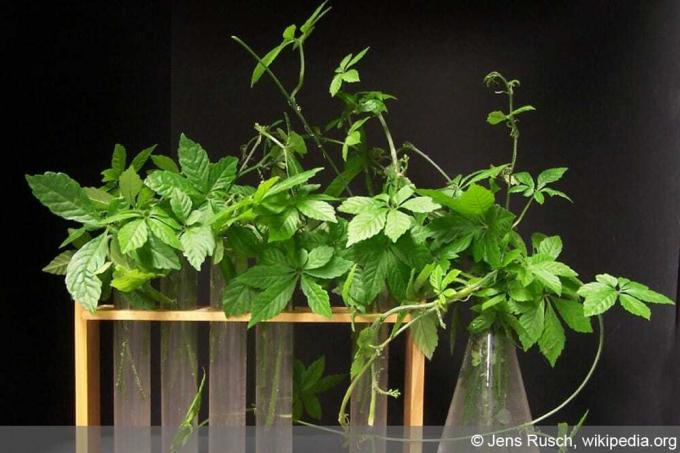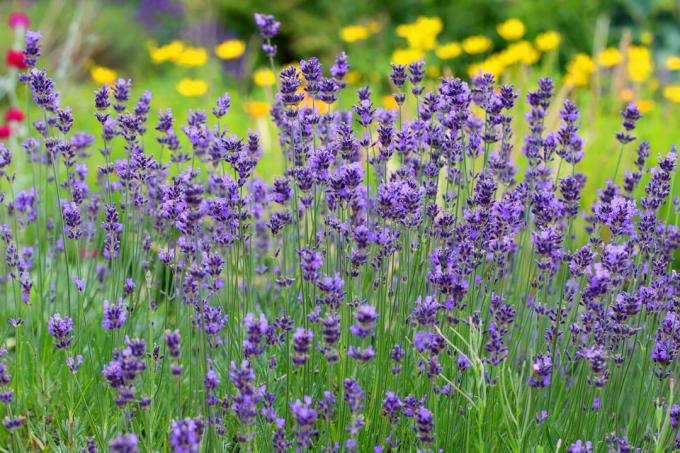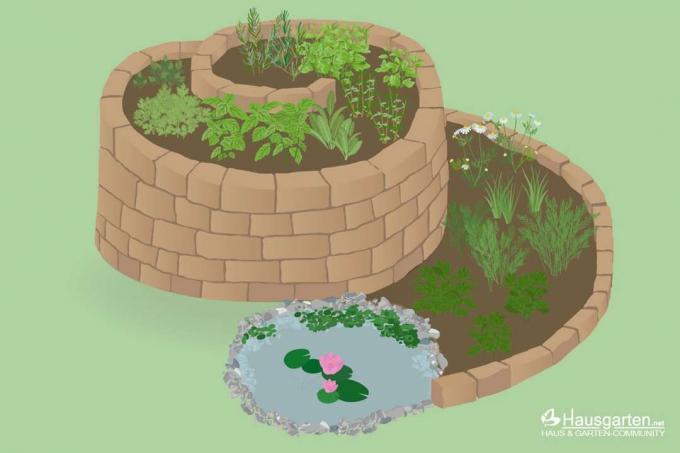

Table of contents
- Location
- substrate
- Pot
- climbing aid
- Pour
- humidity
- Fertilize
- hibernate
- Cut and harvest
- repot
- multiply
- cuttings
- lowering
Home gardeners with a penchant for natural medicinal herbs and decorative houseplants have taken the Jiaogulan plant to their hearts. The Asian climbing plant scores with effective healing powers, to which it owes the name 'herb of immortality'. Her exuberant growth with densely leafed tendrils and dainty flower spikes makes it ideal for indoor cultivation. These instructions will guide you step by step through skilful care and successful propagation.
Location
A look at the climatic conditions in their habitats tells us the ideal light and temperature conditions for cultivating a Jiaogulan plant indoors. The perennial climbing plant is native to the thickets and mountain forests of Asia. Their range extends to India and the entire Malaysian region. The primeval herb of immortality likes a warm, humid climate without blazing sunshine. Although a Gynostemma pentaphyllum can withstand short-term frost down to -15 degrees Celsius, it develops its optimum in the typical rainforest climate. The following criteria characterize the perfect location:
- Partly shaded to shaded position on the east or west window
- Temperatures between 15 and 30 degrees Celsius
- Humidity of at least 60 percent
- Optionally from May to September on the balcony in a warm, wind-protected, partially shaded location
As a location in living rooms, the bathroom has proven to be an excellent choice. Here the growth of your Jiaogulan plant is under a lucky star, because the humid and warm microclimate increases the content of the valuable ingredients in the leaves. This is especially true if the immortality herb is kept out of direct midday sun.
Tip:
The Chinese were already aware of the healing effects of the Jiaogulan plant during the Ming Dynasty around 1400 AD. The scholar Zhu Xiao pointed out in his writings in 1406 that mountain farmers lived more than 100 years in the distribution areas of this climbing plant. A daily cup of tea with the herb of immortality is the secret to a healthy old age.
substrate
The ideal substrate is equal to loose, permeable forest soil. The climbing plant evaporates a lot of moisture via the countless leaves, so that the potting soil should also have a high water storage capacity. Conventional potting soil from the discounter only partially meets the requirements. The high peat content impairs the storage capacity of the water and is also extremely questionable from the point of view of nature conservation. This is how the best possible potting soil for a Jiaogulan plant should be structured:
- Nutrient-rich potting soil with wood or coconut fibers as a peat substitute
- Addition of quartz sand, lava granules or perlite breathing flakes to optimize permeability
- pH between 5.5 and 8.0 (ideally 6.5 to 7.0)
If, as a garden owner, you like to mix the substrate yourself, we recommend using loamy garden soil, sieved compost and quartz sand in a ratio of 3:2:1. So that no pathogens hide in the soil, place the slightly moistened substrate in a fireproof bowl in the oven for 20 minutes at 150 degrees to sterilize it. Put a lid on loosely and clamp a wooden stick or cork in the oven door.
Pot

In view of its impressive dimensions with tendrils up to 300 cm long and a correspondingly large root ball, the pot for a Jiaogulan plant must not be too small. For indoor cultivation, we recommend a container volume of 10 to 20 liters and a depth of 30 cm. Ideally, the planter is made of plastic, as clay pots cool down the root ball very quickly when temperatures drop. The pot size increases proportionally to the growth over the years. It is not uncommon for an adult immortality herb to show itself in a mighty pot with a volume of more than 50 liters.
climbing aid
The Jiaogulan plant is not endowed with attachment organs like the ivy has. In order for the tendrils to gain height, they need a climbing aid. In its Asian homeland, the immortality herb uses the trunks of trees or tall shrubs to climb up to the sky. There are various options available for growing in the room, which are as practical as they are decorative.
- Jumbo trellis as a plant pot with built-in, round trellis
- Bucket with integrated climbing aid, like an obelisk
- Rank-O-Twist, the extendable spiral on a wooden stick with a ground spike
- Planter box with integrated trellis to grow two or more Jiaogulan plants
A stable rose pyramid is quickly converted into a climbing aid for the cultivation of women's ginseng. Place the tendrils in the middle of a bucket that is at least 30 cm deep and tie them to the metal tubes. In this way, over time, the elegant, pyramid-shaped silhouette will develop itself.
Tip:
The valuable ingredients are mainly found in the leaves of a Jiaogulan plant. However, if you are striving for flowering followed by berries, two Gynostemma pentaphyllum are required. As the vine is sexually separate, please cultivate a male and female specimen indoors.
Pour
A Jiaogulan plant wants a constantly moist substrate that neither dries out nor sinks in water. Therefore, water the plant regularly when the surface of the soil is noticeably dry. A short finger test provides certainty about the current watering needs. Press your thumb 1 to 2 cm into the substrate. If you don't feel any moisture here, keep watering with room-warm, stale water until the coaster fills up. To prevent waterlogging, pour out excess water from the saucer after 10 minutes.
humidity
If a location in the humid bathroom is not possible, spray the houseplant with lime-free water at least once a week. An air humidifier set up nearby also makes a valuable contribution to a room climate with 60 percent humidity and more. Clever indoor gardeners fill the saucer with pebbles and water so that the plant is continuously enveloped in evaporating moisture.
Fertilize
For the carefree enjoyment of the rich Jiaogulan leaves as a tea or pure, mineral fertilizers are taboo. Preferably use an organic liquid fertilizer for the nutrient supply, such as organic vegetable fertilizer from Compo or Gardol organic herb fertilizer. If you cultivate vermicompost on the balcony or in the garden, the worm tea obtained from it provides all the nutrients that naturally promote the growth of women's ginseng. How to fertilize the herb of immortality with gardening expertise:
- Fertilize organically from March to October
- Add vegetable or herb fertilizer to the irrigation water every 4 weeks
- Alternatively, apply long-acting organic fertilizer sticks in March and June
Please water with clear water before you fertilize your Jiaogulan plant. Moistened soil absorbs the nutrients more quickly.
hibernate
The light and temperature conditions during the winter time determine whether a jiaogulan plant sheds its leaves or not. Plants grown outdoors fully shed their foliage after the first frost. Deep in the ground, only the thick tuberous roots hibernate as outlasting organs, from which fresh shoots sprout in spring.
If the Asian green plant stayed on the balcony throughout the summer, it should be cleared in good time so that it can continue to bear its rich foliage. When the thermometer falls below 15 degrees, it's high time to move to winter quarters. No relocation is required for year-round indoor cultivation. We have summarized all options for a successful wintering as a houseplant for you below:
- Without falling leaves: bright location at 18 to 22 degrees Celsius (e.g. in a temperate conservatory)
- With leaf shedding: dark and cool at temperatures just above freezing (e.g. in the basement)
- Do not fertilize from October to February
The water balance depends on the general conditions during the winter. The brighter and warmer the location, the more frequently the plant needs to be watered, as it will continue to evaporate moisture through its foliage. If the jiaogulan plant falls into a phase of complete dormancy in the cool, dark cellar, please only water in sips so that the root ball does not dry out.
Cut and harvest
As a herbaceous climbing plant, female ginseng tolerates pruning well. You can trim tendrils that are too long at any time with sharp, disinfected scissors. Before storing in a dark, cool room for the winter, cut off all tendrils to a hand's breadth above the substrate. After a warm winter on the bright window sill, cut back the shoots by up to two-thirds for continuous rejuvenation. The immortality herb then sprout all the more vitally.
The harvest of the leaves is not tied to any fixed time frame. If you would like to prepare a tea from fresh leaves, simply pluck off the required number. To dry the medicinal leaves, it has proven useful in practice to cut off the tips of the shoots, bundle them up and hang them upside down in an airy place.
repot

At intervals of two to three years, the previous pot becomes too small for a Gynostemma pentaphyllum. When the first root strands grow out of the opening in the ground or when the tubers push their way through the substrate, repot the plant into a larger container. The best time for this care measure is early spring, immediately after pruning. How to do it right:
- Lay shards of pottery over the bottom opening in the new pot to protect against waterlogging
- Cover the drainage with a water- and air-permeable fleece
- Fill in a few handfuls of fresh substrate and press down with your hands
- Unpot the plant and shake off the used substrate
- Cut out dead, rotten roots with a sharp, clean knife
Pot the substrate-free root ball in the new bucket, maintaining the previous planting depth. Fill in the fresh substrate gradually and press it down with your hands so that no cavities form. In the last step, water the plant until the saucer fills up.
multiply
Once you grow a jiaogulan plant indoors, you can propagate more specimens via the vegetative propagation route. The focus is on two methods that are as simple as they are promising. The following two short instructions explain the exact procedure:
cuttings
Early summer is the best time to propagate the herb of immortality from cuttings. How to proceed correctly:
- Cut off shoot tips with a length of 10 to 15 cm
- Start the cut just below a leaf
- Cuttings defoliate except for 2 to 4 leaves at the top
- Place in a glass with soft water in a partially shaded, warm window seat
After 3 to 4 weeks, fresh root strands will have formed on the cuttings. At this stage, please change the water repeatedly. Pot a rooted offshoot in loose potting soil and care for it according to these instructions.
lowering
Propagation by sinkers postpones the separation of mother plant and offspring to a later date. Here's how the proven method works:
- Fill a pot with drainage and potting soil
- Stick a wooden stick into the ground at the edge of the pot
- Place next to the adult jiaogulan plant
- Pull down a healthy, non-flowering shoot and place it on the potting soil
- At the point of contact with the substrate, score the shoot lightly with a razor blade and weigh it down with a stone
- Tie the shoot tip of the sinker vertically to the wooden stick
While the mother plant continues to supply the sinker with nutrients, care is limited to regular watering. Meanwhile, fresh roots are sprouting from the wounded tissue. After about a month, this process has progressed so far that you can cut the sinker off the mother plant and care for it as an independent plant.
In contrast to vegetative propagation, generative sowing of seeds proves to be complicated and time-consuming. Furthermore, scientific studies have found that the leaves of seedling-propagated Jiaogulan plants contain only a small proportion of medicinal substances.
 garden editorial
garden editorial I write about everything that interests me in my garden.
Learn more about growing herbs

Basil has black dots: what to do?
Especially basil bought in a pot from the supermarket tends to quickly develop black dots or spots on the leaves. This article explains why this is and what helps against it.

14 kitchen herbs that you can really keep in the kitchen
Sometimes a herb garden is only possible on the windowsill. If you don't have your own garden bed, for example, or in the months when the frost freezes the coveted greenery outside. Our list provides an overview of which herbs like the kitchen location permanently.

Parsley turns yellow: Four tips against yellow leaves
If the leaves of the parsley suddenly turn yellow, the so-called parsley disease is usually behind it. This can have many causes. If the outbreak of the disease is to be prevented, only prevention helps. More about this here.

You can combine lavender with these 13 plants
Whether you use it in the kitchen, want to enjoy its fragrance or its beauty, lavender is a must in any garden. Well combined, it can strengthen other plants or protect them from pests. We present the best plant neighbors.

8 tips for cutting and harvesting herbs properly
Fresh herbs from the garden should not be missing in any kitchen. They are versatile, exude pleasant and spicy scents and are a treat for the eye with their pretty flowers. In the kitchen, they can easily replace artificial flavor enhancers.

Herb spiral & herb snail: this is how it's done
A herb spiral or herb snail makes it possible to plant many different varieties in a particularly decorative way. However, this is not the only advantage of these variants of the culture. You can find out how to create them here.
